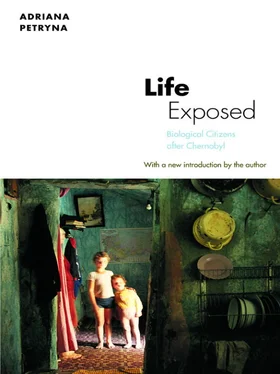Guskova went to meet the first planeload of possible ARS patients airlifted from the Chernobyl accident site and flown to Moscow on April 27, 1986. Initially, over four hundred people were taken from the disaster site to Clinic No. 6. This group consisted mainly of firemen who had extinguished fires in areas around the burning reactor core. Patients described this flame to me as a long green-blue radioactive phosphorescing column. In our interview, Guskova blamed the Soviet radiological service for failing at the outset to provide enough dose-related information for her to make an appropriate assessment of patients’ doses. “We had patients expressing symptoms that were the same as symptoms of ARS, but we did not know the radiation situation.” She relied on semiempirical models to assess patients’ doses. The individuals selected exhibited symptoms of the central nervous system and gastrointestinal syndromes, including fevers, vomiting, and nausea. Changes in the blood composition of these patients were recorded within three days of exposure. [14] Though primary medical attention focused on the group of workers under Guskova’s care in Moscow, many Soviet biologists, cytogeneticists, and biologists associated with the Radiation Research Center in Kyiv were dispatched to the Zone in the first few days following the disaster. They collected blood from children and adults, and documented changes in blood indicators, chromosomes, and genetic constitution (HLA markers).
Guskova’s high-dose human know-how, for lack of a better phrase, was a unique achievement of Soviet radiation science. Chernobyl’s scale and lethality posed challenges that Guskova and her colleagues had not confronted before. Guskova told me that these patients received much higher doses than those she had observed in previous accidents. In one scientific article, she referred to these doses as “overlethal” (1997). An intense graphite fire in the reactor’s graphite-moderated core resulted in combined injuries (burns with symptoms of ARS), making categorization of the victims difficult and “complicat[ing] the nature and effectiveness of interventions” (Baranov et al. 1989:205). [15] The distribution of toxic effects in nuclear accidents can be thought of as encompassing three bodily domains: skin, bone marrow, and other. The fact that each accident results in differing degrees of intensity of injury to each of the three domains means that “it is not possible to devise a specific medical plan for all accidents or to draw conclusion about the value of different medical interventions from a single accident” (Baranov et al. 1989:206).
The majority of deaths in the first three months after exposure were attributed to skin lesions (burns) that involved 50 percent of the body’s total skin surface (Wagemaker et al. 1996:29).
Soviet-American Cooperation
In their 1971 monograph, Radiation Sickness in Man , Guskova and her collaborator Baysogolov conceptualized the organization of medical services for victims of large-scale nuclear catastrophes. They wrote that a “large number of victims introduces a number of forced corrections and apparently somewhat changes therapeutic arrangements.” They considered the introduction of a triage mechanism essential because “detailed investigation is extremely limited in these cases.” They also recommended “using more tranquilizers than is warranted under normal circumstances, considering the mass nature of the injuries and seriousness of the psychological situation” (245).
Guskova relied on a higher threshold dose to facilitate sorting patients at the Chernobyl plant in days following its explosion. A threshold dose is the dose limit above which radiation exposure would likely produce long-term biological effects. Symptoms of ARS begin to manifest themselves at 200 rem. Guskova set the dose at which patient recruitment would begin at roughly 250 rem. The use of a threshold generated an on-site social dynamic. For example, because preclinical examinations were limited, some of the initial selections were faulty. Indeed, during fieldwork in the Radiation Research Center, I met one man who had panicked over having to work at the disaster site. He self-induced vomiting and nausea and was among those airlifted to Clinic No. 6. Later he was released and never returned to the Zone. [16] He currently enjoys all the Ukrainian state benefits associated with his ARS diagnosis.
Such were the semiempirical models at work at the disaster site. Through their implementation, Guskova enacted a procedure, a set of “dividing practices” (Foucault 1984). She limited the group of victims who would be subject to early active therapy and delayed medical evaluation and therapies for workers who were potentially injured at doses below 250 rem. I met a person who estimated her dose to be 220 rem, 30 rem shy of the threshold, but who was excluded from the ARS cohort and therefore required to continue working at the disaster site.
FIGURE 2. Volume of concentrations of cesium-137 in the air at different moments in time after the Chernobyl accident (month, day, hour) according to an atmospheric transfer model. The increase in isopleth number indicates a tenfold increase of concentration (World Health Organization 1996)
• • •
Thousands of people like Dmytro were either voluntarily or involuntarily mobilized to work at the site under perilous circumstances. Administrators simultaneously withheld meteorological information and set occupational standards of radiological exposure artificially high. They also introduced a psychological technique in the effort to control perceptions of risk and interpretations of symptoms for anyone living “beneath” this threshold—evacuees, workers, and inhabitants of unmarked contaminated territories.
Declassified documents illustrate how this technique was introduced. [17] See Chornobyl’ska Tragediia 1996.
In late May 1986 and at the height of East-West bioscientific collaboration, leaders in the Soviet Health Ministry issued an order to Anatolii Romanenko, then Ukrainian health minister, who had not achieved full control over the activities of local medical personnel. Romanenko was ordered to make sure that Ukrainian republican scientific and clinical administrators used a medical diagnosis, “vegetovascular dystonia” (VvD), to filter out the majority of radiation-related medical claims. This condition is akin to panic disorder in the West, but its etiology is different. It was introduced into Soviet medical classification in the 1960s to account for environmental factors, including “mental factors, pollution, stress, or atmospheric factors,” in the initiation of disease. [18] “All those things that we call the environment,” according to one specialist trained in Soviet medical classification. Vegetovascular dystonia (VvD) is a term for disturbances of the autonomic nervous system. It approximates a class of diseases known in the United States as somatoform disorders, which include anxiety disorders with somatic manifestations. VvD is not a diagnosis, nor does it appear in the International Classification of Diseases. Nor does it refer to any specific pathology. VvD is a premorbid state; a person with VvD exhibits “tendencies” to subsequent developments of a pathological state. It is a description of an unspecified state, that is, of a state “between two functional states of the organism, one normal and the other pathological.”
The external symptoms of VvD include anything from heart palpitations, sweating and tremors, nausea, and hypertension to hypotension and neurosis-like disorders, spasms, and seizures. VvD resembles the central nervous system syndrome of ARS, but its cause differs: one is radiation-induced, the other is “environmentally” induced. Romanenko’s directive to Ukrainian medical personnel read as follows:
Читать дальше












